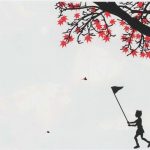Takashi Kawashima: Takashi’s Seasons
Artist(s):
Title:
- Takashi's Seasons
Exhibition:
Creation Year:
- 2007
Category:
Artist Statement:
Over the past century, it has become ordinary to experience motion pictures on large screens
in movie theaters or as video projections. These modern projection instruments developed from what was called the “magic lantern,” invented in Europe during the second half of the 17th century. While the magic lantern was invented in the West, it influenced the emergence of a new type of entertainment in 18th-century Japan known as Utsushi-e, an original hybrid of the ancient Asian shadow play and the Western magic-lantern show. It can be considered a close ancestor of movies, preceding them by a mere century. In Utsushi-e, instead of merely projecting a series of pre-fabricated images on a screen, artists created “motion pictures” via a mixture of live art, light manipulation, narration, and painted images. Artists built on audience response, and an interaction developed between the two. Takashi’s Seasons is a sequential live shadow-puppet show/video performance in which various scenes interpreting the four seasons are performed by a modern Utsushi-e artist. Children are seen walking back to school with their school bags in the spring (the academic year begins in April in Japan). The proud performance of cicadas can be heard on a hot summer evening. Dragonflies smoothly glide in the cool air of a fall afternoon. On New Year’s Eve, the chimes of temple bells are heard in the freezing winter night. This work does not intend to offer a common point of reflection for all to understand and cherish. Rather, the piece intends to evoke personal memories that are strongly tied to the four seasons, interpreted through a Japanese cultural perspective. Through the presented vignettes, this piece vividly brings back those personal memories, presenting them as a unified experience.
Technical Information:
In creating the performance, all props and characters were first sketched on paper, then
created in Adobe Illustrator. After all elements were placed on a 640 x 360 pixel grid, props and characters were divided into physical puppets and video animation. After adjusting the scale of the puppets so the cast shadows would match the scale of the projected imagery, the puppets were output to a laser cutter. The animation was developed in Adobe After Effects using both traditional keyframing and programming in After Effects Expression. The blending of digitally generated animation and projected shadows produced a unique hybrid animation style. A custom switch is connected to two microcontrollers that are in turn connected via a serial cable to a computer mounted on the ceiling. The first AVR microcontroller is directly connected to the switch and is programmed to read electronic signals generated by the switch, converting them to serial messages. The second microcontroller translates these serial signals to Windows OS keyboard commands. Software programmed in Macromedia Flash triggers animations and sound effects based on
keyboard commands from the second microcontroller, allowing synchronization of video animations with the shadow puppets via the switch. The microcontrollers were programmed using C and C#/.NET respectively.







